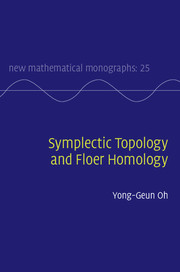Book contents
- Frontmatter
- Contents
- Contents of Volume 2
- Preface
- PART 1 HAMILTONIAN DYNAMICS AND SYMPLECTIC GEOMETRY
- PART 2 RUDIMENTS OF PSEUDOHOLOMORPHIC CURVES
- 7 Geometric calculations
- 8 Local study of J-holomorphic curves
- 9 Gromov compactification and stable maps
- 10 Fredholm theory
- 11 Applications to symplectic topology
- References
- Index
11 - Applications to symplectic topology
from PART 2 - RUDIMENTS OF PSEUDOHOLOMORPHIC CURVES
Published online by Cambridge University Press: 05 September 2015
- Frontmatter
- Contents
- Contents of Volume 2
- Preface
- PART 1 HAMILTONIAN DYNAMICS AND SYMPLECTIC GEOMETRY
- PART 2 RUDIMENTS OF PSEUDOHOLOMORPHIC CURVES
- 7 Geometric calculations
- 8 Local study of J-holomorphic curves
- 9 Gromov compactification and stable maps
- 10 Fredholm theory
- 11 Applications to symplectic topology
- References
- Index
Summary
In this chapter, we illustrate the usage of the machinery of pseudoholomorphic curves by providing the proofs of two basic theorems in symplectic topology. Both of them can be proved by a direct analysis of the compactified moduli space of pseudoholomorphic curves combined with a bit of symplectic topological data. The first one is Gromov's celebrated non-squeezing theorem. In the proof of this theorem, an existence theorem of a certain type of pseudoholomorphic curve is the most essential analytical ingredient. In addition, it also uses the positivity and homological invariance of the symplectic area of closed J-holomorphic rational curves. We closely follow Gromov's original scheme of the proof. In hindsight, the existence result is an immediate consequence of the non-triviality of the one-point (closed) Gromov–Witten invariant on S2 × T2(n−1), which is defined by counting the number of elements of the zero-dimensional moduli space of J-holomorphic curves. We refer readers to (Gr85), (Mc90) for more non-trivial applications of the finer-structure study of the moduli space itself to some structure theorems of ambient symplectic 4-manifolds.
The second one is the proof of the nondegeneracy of Hofer's norm on Ham(M, ω) for arbitrary tame symplectic manifolds. The proof of this theorem uses the moduli space of solutions of the Cauchy–Riemann equation perturbed by time-dependent Hamiltonian vector fields with a Lagrangian boundary condition, and exploits the automatic displaceability of ‘small’ compact Lagrangian submanifolds in arbitrary symplectic manifolds. We closely follow the author's simplification (Oh97c) of Chekanov's proof (Che98). We refer readers to Abouzaid's article (Ab12) for a remarkable application of the finer-structure study of this compactified moduli space to the construction of an exotic Lagrangian sphere in T*S4k+1. His usage is somewhat reminiscent of Donaldson's original application of the moduli space of anti-self-dual Yang–Mills equations in his celebrated construction of exotic ℝ4 (Do86).
- Type
- Chapter
- Information
- Symplectic Topology and Floer Homology , pp. 355 - 376Publisher: Cambridge University PressPrint publication year: 2015



